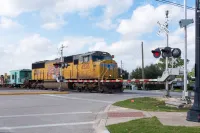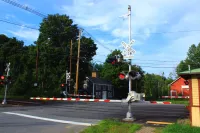
As summer approaches, more cars and trucks are hitting the roads, and TSA wants to remind travelers to be careful around railroad crossings.
According to Operation Lifesaver – a nationally recognized rail safety education leader – a train hits a vehicle or person about every three hours in the U.S.
TSA has a strong partnership with the rail industry, primarily supporting security. However, TSA Surface Operations Support Division Director Henry Budhram said, “Safety and security go hand-in-hand, and TSA uses every opportunity to help promote the need for the public to be safe and secure when traveling over railroad tracks and around signals.”
Bob Dickson was the first TSA surface inspector in Kansas City to build relationships with rail operators and achieve regulation compliance from a security side. As relationships deepened, Dickson said railroads invited TSA to participate in railroad crossing events. Now, when TSA gets railroad crossing safety questions, his team is ready to respond.
“[People] don’t realize that a train traveling 30 miles an hour or greater cannot quickly stop,” said Dickson. “If they see a train in sight, that train probably will not be able to stop before it gets to their car. So, when given the opportunity, we reinforce the message the Federal Railroad Administration (FRA) and railroads send to the public – trains often cannot stop in time. Some of those trains are 110 cars, not counting the power units, and it might take a mile before they can stop, depending on their speed and other conditions.”
When asked how safe railroad crossings are today, Dickson said they’re as safe as they can be based on FRA regulations.
“If the public would heed those signs, those warnings, they would be quite safe,” he proclaimed. “Unfortunately, so many people don’t heed those warnings, alerts. They’ll drive around the barriers. There are some crossings that have lights only or just crossbars – signs to slow down and look before [drivers] cross. If it’s a little used road, [railroad crossings] won’t have the full complement of measures in place. It all depends on the public obeying the warnings, alerts and signs that are present.”
Budhram believes it’s important to promote safety programs like Operation Lifesaver. He said most railroads have created their own personalized Operation Lifesaver-type safety awareness program.
“TSA supports the rail industry in its pursuit of reducing the number of highway-rail crossing collisions,” Budhram said. “As long as there are thousands of tons of equipment traveling on open tracks and limited controls to prevent accidents, railroad crossing safety will be a concern. TSA believes it’s important to message the importance of safety as a measure of precaution.”
The good news is the number of train-vehicle collisions declined 82% between 1972 and 2019, but one accident is one too many. Always expect a train at each highway-rail intersection at any time. Today’s trains are quieter than ever and are always closer and moving faster than you think. Trains have the right of way 100% of the time.


